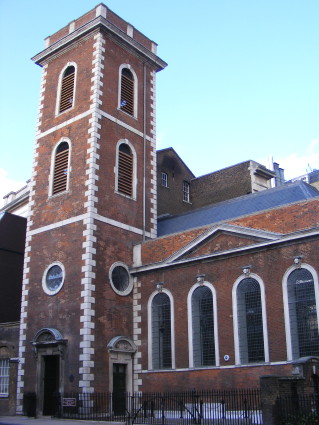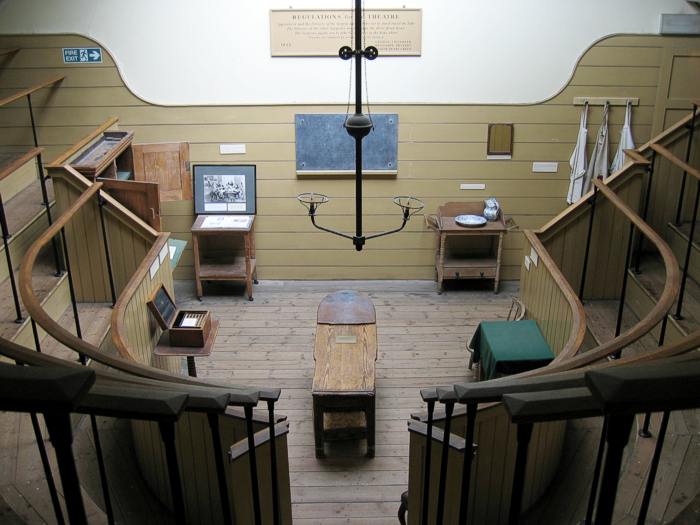Calle Saint Thomas 9 Londres SE1
Este curioso y desconocido museo londinense, es más que un edificio recuperado, de hecho, poco queda de lo que hubo en este lugar, recrea más bien un ambiente, una época y una forma de entender la medicina no tan lejana, además de enfrentarnos a la escalofriante historia de la cirugía. El espacio nos introduce en un ambiente algo siniestro, pero la experiencia nos transporta eficazmente al pasado y resulta muy pedagógica. El museo sólo es accesible a través de una escalera de caracol estrecha de 32 escalones, así que su visita es muy limitada.
Oculto en el bajocubierta de la aneja iglesia barroca de Saint Thomas, cerca del metro Puente de Londres, esta buhardilla herbolario de 300 años esconde el único teatro de operaciones decimonónico recuperado en Inglaterra, desde cuyas gradas de madera entre 1822 y 1862, los estudiantes observaban las operaciones realizadas sin anestesia ni antisépticos. El museo presenta una colección de aparatos quirúrgicos y de anestesia, especímenes patológicos y un muestrario de herboristería y medicina natural.
Esta buhardilla de la iglesia se usó como boticaria del Hospital Saint Thomas, para almacenar y curar las hierbas para los medicamentos, y en 1822 se construyó el teatro de operaciones. El antiguo Hospital del siglo XVII adosado a la iglesia, ha desaparecido, trasladado en 1859 a su lugar actual en Lambeth y el teatro de operaciones permaneció olvidado hasta 1957. En 1962, tras 100 años en desuso, la buhardilla y el teatro de operaciones se abrieron al público como el actual museo.El hospital era de beneficencia, como permite sospechar su adscripción a la iglesia, y se usaba además como maternidad. Los pacientes eran mujeres pobres y se les trataba gratis, se les operaba a vida o muerte y las intervenciones servían como enseñanza a los estudiantes de medicina, por ello es tan pertinente que se recuerde la historia de la cirugía y cómo en su día no se conocía la asepsia, ni las causas de las infecciones (se procuraba operar rápido), ni se usaba anestesia (salvo el alcohol). Hasta 1847 no se empezaron a usar el éter o el cloroformo. Por el contrario, los pacientes ricos eran tratados y operados en sus casas, probablemente en la mesa de la cocina.
Sitio Oficial
Old operating theatre museum and Herb Garret Old operating theatre museum and Herb Garret
9a St Thomas's St London SE1
This curious and unknown London museum is more than a building restored, in fact, little remains of what was in this place.
It rather recreates an atmosphere, a time and a way of understanding medicine not so distant. It also faces us to the chilling history of surgery
The space opens up a sinister atmosphere, but experience effectively transports us to the past and is very educational. The Museum is only accessible via a narrow and steep 32 step spiral staircase, so its visit is very limited.
Hidden in the roof of baroque St Thomas’ Church near London Bridge Underground, this 300-year old herb garret houses Britain’s only surviving operating theatre, with wooden observation stands, from which between 1822 and 1862 students witnessed surgery performed without anaesthesia or antiseptics.
The museum has a collection of surgical apparatus, early devices for anaesthesia and pathological specimens as well as exhibitions covering the history of herbal physic.
This church’s garret use to be the apothecary of Saint Thomas Hospital, to store and cure herbs for medicines and in 1822 the operating theatre was built.
The seventeenth century former hospital attached to the church has disappeared, moved in 1859 to its present site in Lambeth and the operating theater remained forgotten until 1957. In 1962, after 100 years of disuse, the garret and operating theatre were opened to the public as the current museum.
The hospital was charitable, and allows us to suspect its attachment to the church, and was used as well as motherhood.
Patients were poor women who were treated for free, had life or death operations and these served as teaching to medical students. This is why the museum reminds the surgery history and how asepsis was unknown, causes of infection weren’t understood (they tried to operate fast) and anesthetic wasn’t used (except for alcohol). Ether or chloroform didn’t start to be used until 1847. And on the contrary, rich patients were treated and operated at home, probably on the kitchen table.




No hay comentarios:
Publicar un comentario